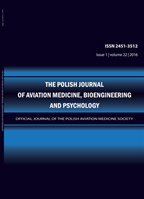2014, Volume 20, Issue 4
Anthropometric and Physical Efficiency Characteristics of Candidates Newly Admitted to the Polish Air Force Academy in Dęblin as Aviation Pilot Students
Andrzej Stelęgowski1, Agata Gaździńska2, Marek Kłossowski3
-------------------------------------------------------------------------------------------------
1Department of Physical Education, Polish Air Force Academy
2Technical Department of Aviation Medicine Examinations and Flight Simulators, Military Institute of Aviation Medicine
3Technical Department of Health Promotion, Military Institute of Aviation Medicine
Autor korenspondencyjny: Andrzej Stelęgowski; Department of Physical Education, Polish Air Force Academy; email: sigma603[at]wp.pl
Full text
Streszczenie
Introduction: The objective of the study was to assess the baseline anthropometric parameters and anaerobic efficiency of military pilot candidates in two successive classes admitted to the Polish Air Force Academy in Dęblin.
Methods: The study included all males admitted as aviation pilot students to two successive classes at the Polish Air Force Academy in Dęblin (PAFA). The study group consisted of 35 cadets admitted in 2012 (group I) and 46 cadets admitted in 2013 (group II). The studies were conducted in October 2012 and 2013. The assessment included the measurements of basic anthropometric parameters, bioimpedance evaluation of body composition and evaluation of anaerobic efficiency in a 30-second Wingate test using a Monark 911 SE ergometer.
Results: The mean age in group I was 19.74±1.44 years while the mean age in group II was 19.33±0.99 years. Comparative analysis of anthropometric parameters and body composition revealed no significant differences between the two groups of cadets (p>0.05). The mean percentage fat tissue content in both groups was about 18.5%, fat-free body mass was over 81%, percentage muscle tissue content was 55.3% and the mean body water content was 59.5%. No underweight or obese individuals were identifi ed on the basis of BMI values. Overweight individuals were identifi ed in the study groups (20% of cadets in group I and 10.4 % of cadets in group II). The assessment of anaerobic efficiency revealed no significant differences between groups with the exception of minimum power (p=0.02).
Conclusions: The somatic build of military aviation pilot candidates is similar to the somatic build of civilian university students in Poland. The baseline values of anthropometric parameters and anaerobic efficiency of candidates present a realistic potential for developing proper fitness and efficiency required from military pilots.
Słowa kluczowe
anaerobic efficiency, anthropometric parameters, body composition, cadets, physical fitness
